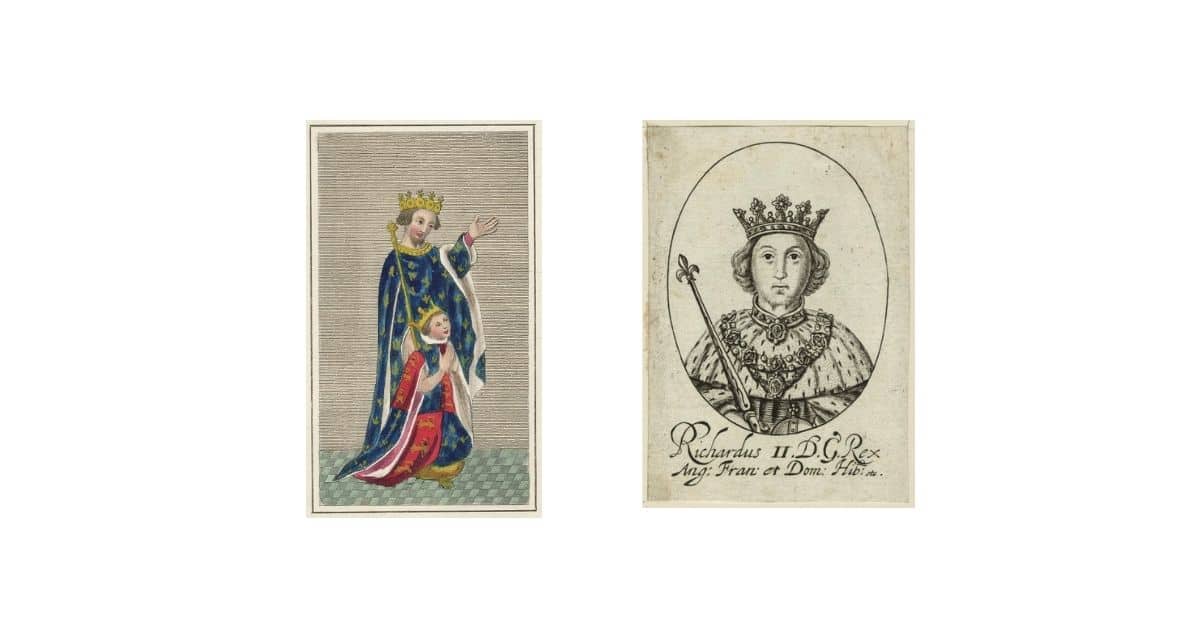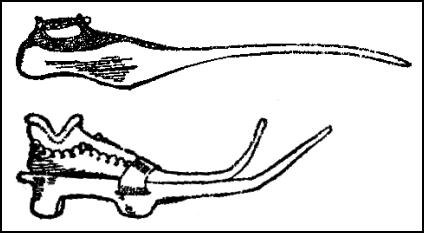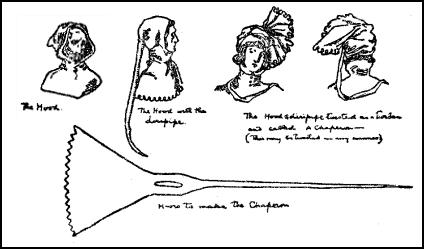By Pauline Weston Thomas for Fashion-Era.com
- A MAN OF THE TIME OF RICHARD II - 1377-1399
- The Houppelande or Peliçon
- A WOMAN OF THE TIME OF RICHARD II - 1377-1399
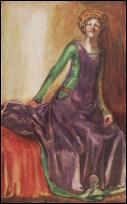 This costume history information consists of Pages 121-140 of the chapter on late 14th century dress in the 22 YEAR REIGN era of Richard The Second 1377-1399 and taken from English Costume by Dion Clayton Calthrop.
This costume history information consists of Pages 121-140 of the chapter on late 14th century dress in the 22 YEAR REIGN era of Richard The Second 1377-1399 and taken from English Costume by Dion Clayton Calthrop.
The 36 page section consists of a text copy of the book ENGLISH COSTUME PAINTED & DESCRIBED BY DION CLAYTON CALTHROP. Visuals, drawings and painted fashion plates in the book have a charm of their own and are shown amid the text. The book covers both male and female dress history of over 700 years spanning the era 1066-1830.
This page is about dress in the reign of King Richard The Second 1377-1399. The images and details are a good resource for costume ideas for Shakespeare's stage plays of the Plantagenet era.
For the Introduction to this book see this introduction written by Dion Clayton Calthrop. I have adjusted the images so they are mostly 400 pixels high and can be used for colouring worksheets where pupils add some costume/society facts.
My comments are in italics.
RICHARD THE SECOND - 1377-1399
Reigned twenty-two years: 1377-1399
Born 1366. Married, 1381, Anne of Bohemia; 1395, Isabella of France.
THE MEN
The King himself was a leader of fashion; he had by grace of Nature the form, face, and manner which go to make a dandy. The nobles followed the King; the merchants followed the nobles after their kind; the peasants were still clothed in the simplest of garments, having retained the Norman tunic with the sleeves pushed back over the wrist, kept the loose boots and straw gaiters, and showed the improvement in their class by the innovation of gloves made as a thumb with a pouch for the fingers, and pouches for money of cloth and leather hung on a leather belt. This proved the peasant to be a man of some substance by need of his wallet. Everyone wore the chaperon - a cap and cape combined.
The Poll Tax of 1380
We have now arrived at the reign which made such a difference to the labourer and workman - such as the blacksmith and miller - and in consequence altered and improved the character of his clothes. The poll-tax of 1380 brought the labourer into individual notice for the first time, and thus arose the free labourer in England and the first labour pamphlets.
We have two word-pictures of the times of the greatest value, for they show both sides of the coin: the one by the courtly and comfortable Chaucer, the other by Long Will - William Langland, or Piers the Plowman. Picture the two along the Strand - Long Will singing his dirges for hire, and Chaucer, his hand full of parchments, bustling past.
One must remember that, as always, many people dressed out of the fashion; that many men still wore the cotehardie, a well-fitting garment reaching half-way down the thigh, with tight sleeves coming over the hand, decorated with buttons under the sleeve from the elbow to the little finger. This garment had a belt, which was placed round the hips; and this was adorned in many ways: principally it was composed of square pieces of metal joined together, either of silver, or enamel in copper, or of gold set with precious stones.

Medieval Gowns
The Cotehardie 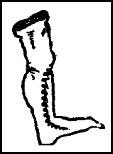
The cotehardie was generally made of a pied cloth in horizontal or diagonal bars, in silk or other rich fabric. With this garment the chaperon (to be more fully described) was worn as a hood; the legs were in tights, and the feet in pointed shoes a little longer than the foot.
A pouch or wallet depended from the belt, and a sheath containing two daggers, an anelace, and a misericorde. The pouch was a very rich affair, often of stamped gilded leather or sewn velvet - ornamented, in fact, according to the purse of the wearer. In winter such a man as he of the cotehardie would wear an overcoat with an attached hood. This coat was made in various forms: one form with wide sleeves the same width all the way down, under which were slits in the coat to enable the wearer to place his hands inside, as in the modern Raglan coat-pocket.
Another form was made very loose and without sleeves, but with the same slits at the side; it was buckled round the waist on occasion by a broad leather belt, very plain. The common heavy travelling-coat was made in this way, and it was only the very fashionable who wore the houppelande for riding or travelling. Sometimes such a man would wear in winter about the town a cloak fastened over the right shoulder with three or four buttons, leaving the right arm free; such a cloak is seen in the brass of Robert Attelathe, Mayor of Lynn.
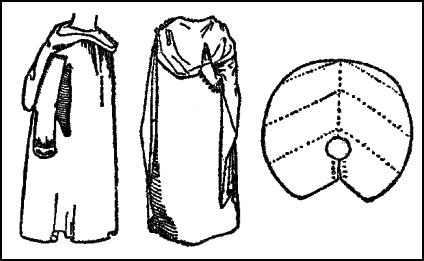
In travelling, our gentleman would wear, often in addition to his chaperon, a peaked hat of cloth, high in the crown, with a brim turned up all round, ending in a long peak in front - the same hat that we always associate with Dick Whittington.
His gloves would be of leather, often ornamented with designs on the back, or, if he were a knight, with his badge.
Baldric
On this occasion he would wear his sword in a baldric, a long belt over his right shoulder and under his left arm, from which hung also his daggers. Although I am not dealing even with personal arms, one must remember, in representing these people, that daggers were almost as necessary a part of dress as boots or shoes, and that personal comfort often depended upon a skilful use of that natty weapon; the misericorde was used to give the coup de grâce.
The farmer in harvest-time wore, if he did not wear a hood, a peaked hat or a round, large-brimmed straw hat.
High Fashion In the Middle Ages
The Houppelande or Peliçon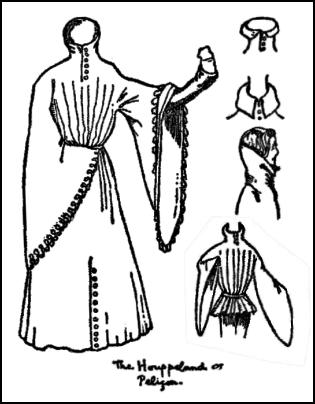
We may now arrive at the fashionable man, whose eccentricities in clothes were the object of much comment. How the houppelande or peliçon actually was originated I do not know, but it came about that men suddenly began to clothe themselves in this voluminous and awkward garment. It was a long loose-fitting robe, made to fit on the shoulders only, having very long loose sleeves, varying according to the whim of the owner.
Houppelande Sleeves
These sleeves were cut at the edges into the forms of leaves or other designs, and were lined, as the houppelande, with fur or silk. It will be seen that such a garment to suit all weathers and temperatures must be made of various materials and lined accordingly. These materials were almost invariably powdered with badges or some other device, sometimes with a flowing pattern embracing an heraldic design or motto. The sleeves turned back disclosed the sleeve of a cotehardie underneath, with the little buttons running from the elbow to the first knuckle of the little finger.
Houppelande Collars
The houppelande had a very high collar, coming well up to the middle of the back of the head; it was buttoned up to the chin in front, and the collar was often turned down half-way, the two top buttons being left undone. It was fastened about the middle by a thin leather belt, very long; this was buckled, and the long end turned under and brought over to hang down; the end was ornamented with many devices - figures of saints, heraldic figures, or other ornaments. Sometimes the entire belt was sewn with small devices in precious metal or enamels.
Long or Short Houppelande
Now, to be in the height of fashion, one either wore the houppelande extremely long in the skirt or extremely short - so short, in fact, as to leave but a frill of it remaining below the waist - leaving the sleeves still their abnormal length. Pretty fads, as tying a dagger round the neck, or allowing it to hang low between the legs, or placing it in the small of the back, were much in vogue.
Mens Hair & Accessories
Every form of beard or moustache was used, and the hair was worn long to the nape of the neck. By the dandy it was elaborately pressed and curled at the ends. Bands of real or artificial flowers encircled the heads of the dandies, the artificial flowers made in enamels or gold. Rings were worn of great size on thumb and finger; long staffs with elaborate heads were carried.
Under the houppelande was the skirt and the cotehardie of thin material, and on the legs hose, pied or powdered, made of silk or cloth cut to the form and sewn.
6 Inch Pointed Toe Shoes
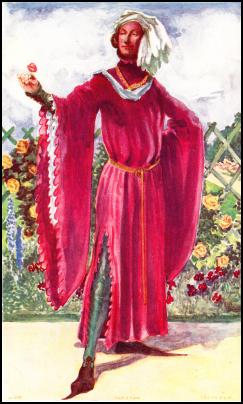 The shoes were of great length, with long points; rarely we find examples of the absurd fashion of wearing the points so long that they were tied back to the knees, but often they were so long that the points came out 6 inches beyond the toe. They were made of every material, sewn with pearls on cloth or velvet, stamped with gold on leather, or the leather raised. The toes were sometimes stuffed hard, sometimes allowed to hang limp.
The shoes were of great length, with long points; rarely we find examples of the absurd fashion of wearing the points so long that they were tied back to the knees, but often they were so long that the points came out 6 inches beyond the toe. They were made of every material, sewn with pearls on cloth or velvet, stamped with gold on leather, or the leather raised. The toes were sometimes stuffed hard, sometimes allowed to hang limp.
For walking in the streets high clogs of wood were used, made with long pointed ends to support the shoes.
I may add that the hose were gartered below the knee to hold them taut with rich garters, but if a man were a Garter Knight he wore but the garter of his Order.
Much in favour with this court of gallants were rich chains about the neck, having for pendant their badge or some saint's figure in gold or silver.
A MAN OF THE TIME OF RICHARD II - 1377-1399
Right - His chaperon, or hood, is twisted and tied about his head with the liripipe, the elongated peak of his hood, thrown over his shoulders.
The Chaperon Cape Hood
Now we come to the most interesting and universal fashion of wearing the chaperon, which I am anxious to show in its various stages. It began with a cape and a hood worn separately; these were joined for convenience so that a man might put on both at once.
This fashion held for many years, and then the fashionable man in search of novelty caused the peak of the hood to be lengthened until it grew to reach to his feet.
Chaperon Styles
Then he cast about for a fresh mode for his head-wear, and so he twisted the whole affair about his head, leaving the end of the cape, which was jagged at the edge, protruding like a cockscomb. Time went on, and he avoided the trouble of tying this himself, so he had the hat made up all ready tied, much in the manner of a turban.
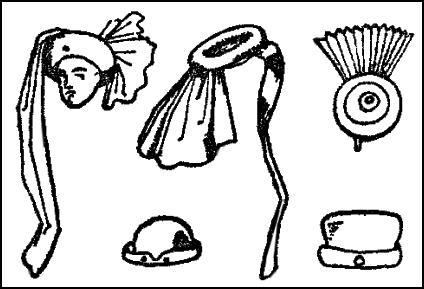
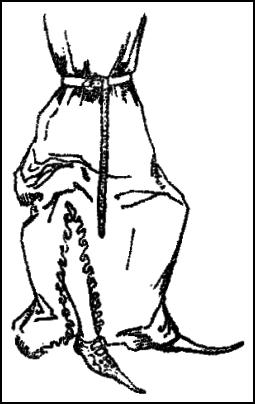 Finally, the chaperon grew into disuse, and it remains to-day a curious reminder in the cockade worn by coachmen (it is almost a replica in miniature, with the round twist and the jagged edge sticking up above the hat) and on the cloaks of the Knights of the Garter, where it is carefully made, and forms a cape on the right shoulder, and in the present head-dress of the French lawyer, a relic of the Middle Ages.
Finally, the chaperon grew into disuse, and it remains to-day a curious reminder in the cockade worn by coachmen (it is almost a replica in miniature, with the round twist and the jagged edge sticking up above the hat) and on the cloaks of the Knights of the Garter, where it is carefully made, and forms a cape on the right shoulder, and in the present head-dress of the French lawyer, a relic of the Middle Ages.
The chains worn about the neck remain as badges of office in Mayors and Judges and in various Orders.
The button worn by the members of the Legion of Honour and other foreign Orders is, I believe, an idea resulting from the cockade, which, of course, was at the beginning the chaperon in the colours of the servant's lord.
When one knows a custom so well, one is apt to leave out many things in describing it. For example, the houppelande was open from the bottom of the skirt to the knee in front or at the side, and this opening was often cut or jagged into shapes; also it was open all the way up the side of the leg, and from the neck to the breast, and buttoned over.
I have not remarked on the jester, a member of many households, who wore an exaggeration of the prevalent costume, to which bells were attached at all points.
So was much good cloth wasted in vanity, and much excellent time spent upon superfluities, to the harm of the people; perhaps useful enough to please the eye, which must have been regaled with all these men in wonderful colours, strutting peacockwise.
C14th Poor Peasants
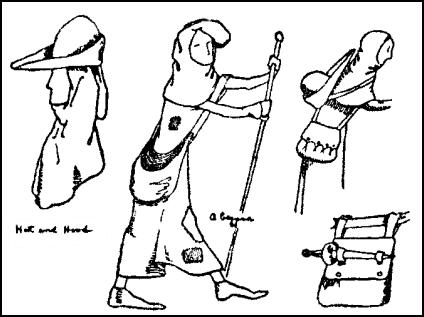
The poor peasant, who found cloth becoming very dear, cared not one jot or tittle for the feast of the eye, feeling a certain unreasonable hunger elsewhere.
And so over the wardrobe of Dandy Richard stepped Henry, backed by the people.
THE WOMEN
Medieval Hair Fashions
If ever women were led by the nose by the demon of fashion it was at this time. Not only were their clothes ill-suited to them, but they abused that crowning glory, their hair.
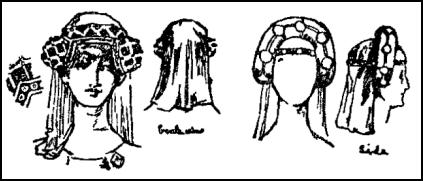
No doubt a charming woman is always charming, be she dressed by woad or worth; but to be captivating with your eyebrows plucked out, and with the hair that grows so prettily low on the back of the neck shaved away - was it possible? I expect it was.
The days of high hennins was yet to come; the day of simple hair-dressing was nearly dead, and in the interval were all the arts of the cunning devoted to the guimpe, the gorgières, the mentonnières, the voluminous escoffions.
Hair Fashions - Chaplets
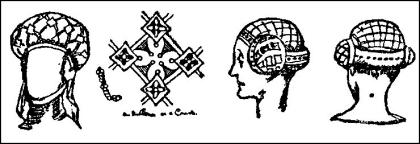
At this time the lady wore her hair long and hanging freely over her shoulders; her brows were encircled by a chaplet, or chapel of flowers, real or artificial, or by a crown or plain circlet of gold; or she tucked all her hair away under a tight caul, a bag of gold net enriched with precious stones.
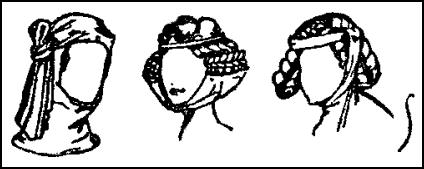
C14th Hair Fashions - Wimple, Caul & Dorelet
To dress hair in this manner it was first necessary to plait it in tight plaits and bind them round the head, then to cover this with a wimple, which fell over the back of the neck, and over this to place the caul, or, as it was sometimes called, the dorelet. Now and again the caul was worn without the wimple, and this left the back of the neck exposed; from this all the hair was plucked.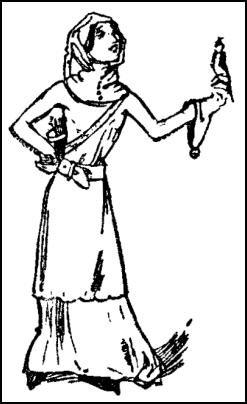
For outdoor exercises the lady would wear the chaperon (explained in the previous chapter), and upon this the peaked hat.
C14th Poor Peasant Woman
The poorer woman wore always the hood, the wimple tied under the chin, or plain plaited hair.
One must remember always that the advance of costume only affected the upper classes in the towns, and that the knight's lady in the country was often fifty years behind the times in her gowns. As an instance of this I give the fur tippet hung with bells, used when hawking.
Medieval Womens Cotehardie
In the early part of the reign the cotehardie was the universal woman's garment. It was made in two ways: the one a simple, well-fitting garment, skirts and bodice in one, buttoned in front, with neck well open, the skirts ample and long, the sleeves over the hands to the first joints of the fingers, and ornamented with buttons from the elbow to the little finger - this was the general form of the garment for all degrees of rank.
The lady enriched this with a belt like a man's, narrow in width round the waist with hanging end, or broad round the hips and richly ornamented. The other form of cotehardie was exactly as the man's, ending short below the hips, under which was worn the petticoat.
The Medieval Surcoat
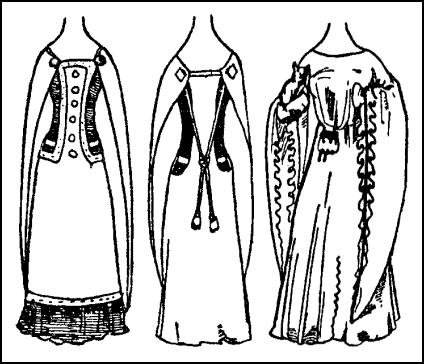
The winter addition to these was the surcoat (as usually worn by a knight over his armour); this was often lined with fur. The surcoat was a long garment without sleeves, and with a split down the sides from the shoulder to the top of the thigh; through this split was seen the cotehardie and the hip-belt. The edges were trimmed with fur, and very frequently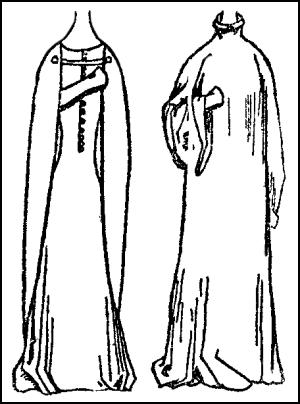 ornamental buttons were worn down the front.
ornamental buttons were worn down the front.
Over the shoulders was the cloak, left open in front, and fastened by means of a cord of rich substance passing through two loops in the backs of large ornamental studs; this cord was, as a rule, knotted at the waist, the ends hanging down as tassels.
The Early Houppelande
Later in the reign, when the second Queen of Richard had brought over many rich fashions, the ladies adopted the houppelande, with its heavy collar and wide, hanging sleeves. Every lady and most women carried a purse in the hand or on the girdle, ornamented according to their station.
The merchant's wife wore, in common with her maids, a white apron. The child who was spinning a peg-top in the street was simply dressed in a short-skirted cotehardie.
Medieval Riding & Sport Fashion
For riding and sport the woman was dressed almost exactly as a man - with houppelande or heavy cloak buttoned on the right shoulder, hawking-glove on her left hand with a bell or metal ball depending from it. She wore boots laced up at the side, or long boots of soft leather fastened with hook and eye; shoes like a man's, but not so pointed and extreme. Sometimes for riding a big round hat was worn over a hood.
In many cases the dresses were powdered with the monogram of the Blessed Virgin, with badges of the family or some small device, or they were ornamented with a simple flowing pattern, or were plain.
A WOMAN OF THE TIME OF RICHARD II - 1377-1399
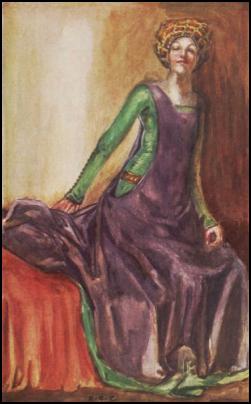 Left - The lady wears a loose surcoat which has been cut away to show her under-dress. Notice how her 'yellow' hair is almost totally hidden by her jewelled caul, sometimes also know as the dorelet.
Left - The lady wears a loose surcoat which has been cut away to show her under-dress. Notice how her 'yellow' hair is almost totally hidden by her jewelled caul, sometimes also know as the dorelet.
All the fripperies of fashion lay in pins for the wimple, the head made as a figure of a patron saint; or girdles rich with precious stones; or mirror-cases on whose ivory fronts were carved the Castle of Love, or hunting scenes, or Calvary. The clasps of purses were rich in design, and rings of every kind were worn on every finger and upon the thumb. Charms against evil were hung about the neck or sewn into the clothes. No matter who wrote, passed, and practised the many sumptuary laws, still, one may know it to have been frequent for persons owning less than £20 a year to wear gold and silver ornaments, although expressly forbidden, and ladies of a lower estate than wives of knights-banneret wore cloth of gold and velvet, and gowns that reached and trailed upon the ground, while their husbands braved it in ermine and marten-lined sleeves which swept the road.
The custom of wearing crowns was common to all people of rank, as heraldic distinction of crowns did not commence until the sixteenth century.
Rich Colourful Medieval Fashion For Women
What a magnificent time for colour was this reign! - the rich houppelandes, the furs, the long-piked shoes with pearls and gold upon them, the massive chains about men's necks; ladies whose heads shone with rich caps and cauls of pearl-embroidered gold, the rich-sheathed baselard stuck in the girdle or hanging from it on a silver chain. Even the poor begging friar was touched by all this finery, and, forgetful of the rules of Saint Francis, he made great haste to convert his alms into a furred cote 'cutted to the knee and quaintly buttoned, hose in hard weather fastened at the ankle, and buckled shoes.'
Imagine that amazing woman the Wife of Bath, in her great hat and pound-weight kerchief; the carpenter's wife in her gored apron, at her girdle a purse of leather hanging, decorated with silk tassels and buttons of metal.
It is almost impossible to describe clearly the head-dresses - the great gold net bags which encased the hair - for they were ornamented in such different ways, always, or nearly always, following some pattern in diaper in contrast to the patterns which came later when the design followed such lines as are formed by wire-netting, while later still the connecting-thread of the patterns was done away with and the inside decoration alone remained.
Well, Richard the King no longer can whistle to Matthew, his favourite greyhound, and Anne the Queen lies stately in the Abbey at Westminster without solace of her little lap-dog; but we are not all modern in our ways, and ladies hang charms about them, from scarabs to queer evil eye coral hands, from silver shoes to month-stones. Crowns of flowers have been worn and crowns of jewels too, just as men and women wore them then, except on Fridays and the eves of fêtes.
These things we do, and other ancient things beside, but let us hope that Fashion has lost her cruel mood, and deems it wise to leave our ladies' eyebrows where they be, nor schemes to inspire her faithful devotees with mad desires to hide their hair and shave their napes.
The crinoline is threatened - let it come; sandals are here, with short hair and the simple life, but leave me, I pray thee, royal dame, an eyebrow on my lady, if only to give occupation to the love-lorn sonneteer.
English Costume by Dion Clayton Calthrop RICHARD THE SECOND Reigned twenty-two years: 1377-1399
Born 1366. Married, 1381, Anne of Bohemia; 1395, Isabella of France.
 This costume history information consists of Pages 121-140 of the chapter on late 14th century dress in the 22 YEAR REIGN era of Richard The Second 1377-1399 and taken from English Costume by Dion Clayton Calthrop.
This costume history information consists of Pages 121-140 of the chapter on late 14th century dress in the 22 YEAR REIGN era of Richard The Second 1377-1399 and taken from English Costume by Dion Clayton Calthrop.
The 36 page section consists of a text copy of the book ENGLISH COSTUME PAINTED & DESCRIBED BY DION CLAYTON CALTHROP. Visuals, drawings and painted fashion plates in the book have a charm of their own and are shown amid the text. The book covers both male and female dress history of over 700 years spanning the era 1066-1830.
This page is about dress in the reign of King Richard The Second 1377-1399. The images and details are a good resource for costume ideas for Shakespeare's stage plays of the Plantagenet era.
For the Introduction to this book see this introduction written by Dion Clayton Calthrop. I have adjusted the images so they are mostly 400 pixels high and can be used for colouring worksheets where pupils add some costume/society facts.
My comments are in italics.
You have been reading English Costume History at www.fashion-era.com © from the chapter Richard The Second 1377-1399, from Dion Clayton Calthrop's book English Costume.
Page Added 5 August 2010. Ref:-P795.
